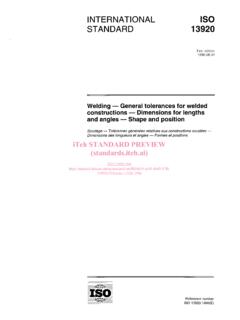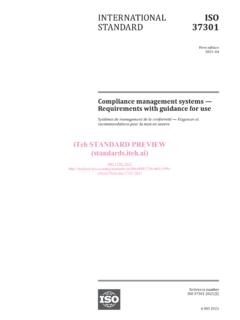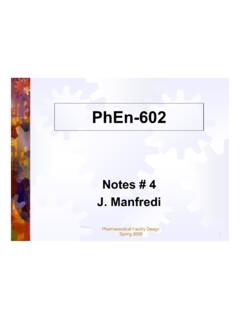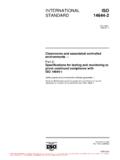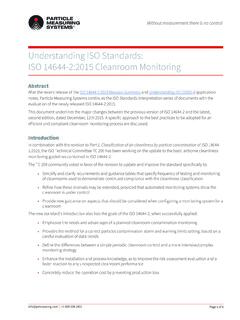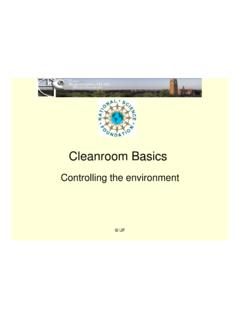Transcription of INTERNATIONAL ISO STANDARD 14644-2 - iTeh Standards …
1 ISO 2015 Cleanrooms and associated controlled environments Part 2: Monitoring to provide evidence of cleanroom performance related to air cleanliness by particle concentrationSalles propres et environnements ma tris s apparent s Partie 2: Surveillance du maintien des performances de la salle propre pour la propret particulaire de l airINTERNATIONAL STANDAR DISO14644-2 Second edition2015-12-15 Reference numberISO 14644 -2:2015(E)iTeh STANDARD PREVIEW( )ISO 14644 -2:2015 ISO 14644 -2:2015(E) ii ISO 2015 All rights reservedCOPYRIGHT PROTECTED DOCUMENT ISO 2015, Published in SwitzerlandAll rights reserved. Unless otherwise specified, no part of this publication may be reproduced or utilized otherwise in any form or by any means, electronic or mechanical, including photocopying, or posting on the internet or an intranet, without prior written permission.
2 Permission can be requested from either ISO at the address below or ISO s member body in the country of the copyright officeCh. de Blandonnet 8 CP 401CH-1214 Vernier, Geneva, SwitzerlandTel. +41 22 749 01 11 Fax +41 22 749 09 STANDARD PREVIEW( )ISO 14644 -2:2015 ISO 14644 -2:2015(E) Foreword ..ivIntroduction ..v1 Scope ..12 Normative references ..13 Terms and definitions ..14 Creating, implementing and maintaining a monitoring plan .. Principle .. Risk assessment .. Monitoring plan .. Calibration .. Review and Response to a deviation during monitoring ..45 Periodic classification of air cleanliness by particle concentration ..4 Annex A (informative) Matters to consider when developing a monitoring plan ..5 Annex B (informative) Considerations for setting alert and action levels.
3 9 Bibliography ..14 ISO 2015 All rights reserved iiiContents PageiTeh STANDARD PREVIEW( )ISO 14644 -2:2015 ISO 14644 -2:2015(E)ForewordISO (the INTERNATIONAL Organization for Standardization) is a worldwide federation of national Standards bodies (ISO member bodies). The work of preparing INTERNATIONAL Standards is normally carried out through ISO technical committees. Each member body interested in a subject for which a technical committee has been established has the right to be represented on that committee. INTERNATIONAL organizations, governmental and non-governmental, in liaison with ISO, also take part in the work. ISO collaborates closely with the INTERNATIONAL Electrotechnical Commission (IEC) on all matters of electrotechnical procedures used to develop this document and those intended for its further maintenance are described in the ISO/IEC Directives, Part 1.
4 In particular the different approval criteria needed for the different types of ISO documents should be noted. This document was drafted in accordance with the editorial rules of the ISO/IEC Directives, Part 2 (see ).Attention is drawn to the possibility that some of the elements of this document may be the subject of patent rights. ISO shall not be held responsible for identifying any or all such patent rights. Details of any patent rights identified during the development of the document will be in the Introduction and/or on the ISO list of patent declarations received (see ).Any trade name used in this document is information given for the convenience of users and does not constitute an an explanation on the meaning of ISO specific terms and expressions related to conformity assessment, as well as information about ISO s adherence to the WTO principles in the Technical Barriers to Trade (TBT) see the following URL: Foreword - Supplementary informationThe committee responsible for this document is ISO/TC 209, Cleanrooms and associated controlled second edition cancels and replaces the first edition (ISO 14644 -2:2000), which has been technically revised 14644 consists of the following parts, under the general title Cleanrooms and associated controlled environments: Part 1.
5 Classification of air cleanliness by particle concentration Part 2: Monitoring to provide evidence of cleanroom performance related to air cleanliness by particle concentration Part 3: Test methods Part 4: Design, construction and start-up Part 5: Operations Part 7: Separative devices (clean air hoods, gloveboxes, isolators and mini-environments) Part 8: Classification of air cleanliness by chemical concentration (ACC) Part 9: Classification of surface cleanliness by particle concentration Part 10: Classification of surface cleanliness by chemical concentrationAttention is also drawn to ISO 14698, Cleanrooms and associated controlled environments Bio-contamination control: Part 1: General principles and methods Part 2: Evaluation and interpretation of bio-contamination data iv ISO 2015 All rights reservediTeh STANDARD PREVIEW( )ISO 14644 -2:2015 ISO 14644 -2:2015(E)IntroductionThis revision of ISO 14644 -2 emphasizes the need to consider a monitoring strategy in addition to the initial or periodic execution of the classification of a cleanroom or clean zone in accordance with ISO 14644 -1.
6 2015, The monitoring activity provides a continuing flow of data over time, thereby providing a more detailed view of the performance of the benefits gained from monitoring are faster response to adverse events and conditions, ability to develop trends from data over time, integration of data from multiple instruments, enhanced knowledge of installation and process, which allows for more effective risk assessment, and improved control of operational costs and product 14644 -2 specifies the requirements of a monitoring plan, based on risk assessment of the intended use. The data obtained provide evidence of cleanroom or clean zone performance related to air cleanliness by particle some circumstances, relevant regulatory agencies may impose supplementary policies, requirements or restrictions.
7 In such situations, appropriate adaptations of the monitoring procedures may be required. After a monitoring plan is initially established and implemented, it may be necessary to revise the plan when significant changes are made to the installation or process requirements. It is also prudent to conduct periodic reviews of a monitoring plan based on data obtained and experience in use. ISO 2015 All rights reserved viTeh STANDARD PREVIEW( )ISO 14644 -2:2015 STANDARD PREVIEW( )ISO 14644 -2:2015 Cleanrooms and associated controlled environments Part 2: Monitoring to provide evidence of cleanroom performance related to air cleanliness by particle concentration1 ScopeThis part of ISO 14644 specifies minimum requirements for a monitoring plan for cleanroom or clean zone performance related to air cleanliness by particle concentration, based upon parameters that measure or affect airborne particle part of ISO 14644 does not address condition monitoring of aspects such as vibration or general maintenance of the engineering systems.
8 It does not provide for monitoring of particle populations that are outside the specified lower threshold particle-size range, 0,1 m to 5 m. Concentrations of ultrafine particles (particles smaller than 0,1 m) will be addressed in a separate Normative referencesThe following documents, in whole or in part, are normatively referenced in this document and are indispensable for its application. For dated references, only the edition cited applies. For undated references, the latest edition of the referenced document (including any amendments) 14644 -1:2015, Cleanrooms and associated controlled environments Part 1: Classification of air cleanliness by particle concentration3 Terms and definitionsFor the purposes of this document, the terms and definitions given in ISO 14644 -1 and the following undertaken in accordance with a defined method to determine the performance of an installation or an element made by measurement in accordance with a defined method and plan to provide evidence of the performance of an installationNote 1 to entry: Monitoring may be continuous, sequential or periodic.
9 And if periodic, the frequency shall be 2 to entry: This information may be used to detect trends in operational state and to provide process levellevel of a parameter set by the user which, when exceeded, requires immediate intervention, including investigation of cause, and corrective actionINTERNATIONAL STANDARD ISO 14644 -2:2015(E) ISO 2015 All rights reserved 1iTeh STANDARD PREVIEW( )ISO 14644 -2:2015 ISO 14644 -2:2015(E) levellevel of a parameter set by the user giving early warning of a drift from normal conditions, which, when exceeded, should result in increased attention or corrective action4 Creating, implementing and maintaining a monitoring PrincipleIn order to gain assurance that a cleanroom or clean zone is performing adequately by delivering the required control of air cleanliness by particle concentration, a monitoring plan shall be created, implemented and monitoring plan shall take into account the level of air cleanliness required, critical locations and performance attributes of the cleanroom or clean zone that affect the performance of the installation.
10 The following steps shall be included in the creation, implementation and maintenance of the monitoring plan: use appropriate risk assessment tools to understand, evaluate and document the risk of adverse contamination events; develop a written monitoring plan; review and approve the plan; implement the plan by performing the monitoring; analyse the data derived from the monitoring activity, undertake trend analysis where appropriate and report performance; implement and document actions or corrective actions required; undertake periodic review of the monitoring concentration of airborne particles measured under a monitoring plan may be higher than the concentration observed during at-rest classification. The observed values may fluctuate considerably due to factors such as, but not limited to, the number of personnel present, the airflow rate, ventilation effectiveness, the operation of instruments or machinery, and activities in adjacent processes that inherently produce particles as part of the process and where these particles are not a threat to the process or product, it may be appropriate to rely on periodic at-rest classification, or operational classification of simulated operations, rather than monitoring of airborne particles in operation.

